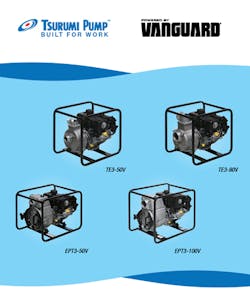Tsurumi Pump to Offer Briggs and Stratton’s Vanguard Engines as Option on EPT and TE Series Pumps
Tsurumi Pump has partnered with Briggs and Stratton to offer North American users its engine-driven trash and dewatering pumps another choice and continuous high level of after-sales support. This enables popular models in Tsurumi’s EPT and TE series to achieve compliance with the latest regulations of California’s Air Resources Board (CARB) and allow them to be sold in the state.
The Vanguard Series engines will offer the same horsepower and RPM figures, and be an option on 2-inch and 3-inch centrifugal dewatering pumps and 2-inch and 4-inch trash pumps, under the TE3-50V and TE3-80V, and EPT3-50V and EPT3-100V model designations, respectively.
Standard features on Vanguard single-cylinder engines include an integrated cyclonic air cleaner that doubles air filter replacement intervals to 600 hours, an acoustically designed fuel tank and muffler optimized to reduce noise, and easy, one-pull starting in cold temperatures as low as -20° F.
No changes to the design and performance of the Tsurumi products were required, thanks to a close partnership between the two companies as they worked to optimize the integration of the Vanguard engines. After carrying out extensive research with Tsurumi customers before entering the new segment, Briggs and Stratton made several innovative, yet common-sense, modifications to improve its engines’ suitability further.
As an example, Briggs and Stratton ensured the fuel shut-off system is automatically engaged when the engine is switched off, thereby reducing the risk of a fuel/oil mix and removing the need for a separate button that is subject to damage. This makes the new Vanguard option an attractive proposition for rental companies in particular.
Thinking ahead
The decision to add a new engine option was initially inspired by supply chain problems in recent years. While these issues have almost been entirely resolved, Mike Grant, Tsurumi’s portable products and rental market manager, said that this product offering still offers many advantages to his company and customers alike.
“We’re already very well caught up with the recent increase in demand for these pumps, so adding the Vanguard option is another way to better serve our customers,” Grant said. “We see this as an opportunity to expand our product line by offering an engine option that is of equivalent quality. Briggs and Stratton have been building engines for well over a century, so our goal is to attract a significant customer base that prefers Vanguard power. In fact, we already have one national account that is considering standardizing its small equipment to run on these engines because of the vast service and support network.
“We’ve turned a potential disadvantage into an opportunity and are now able to sell our engine-driven pumps in every one of the 50 states, which further boosts our sustainability credentials. And, in the unlikely event of another supply chain issue in the future, we’ll be in a much better position to tackle it.”
Beneath the service
The new Vanguard option will also provide Tsurumi customers with widely available maintenance support. For example, upon registering their purchase on the Briggs and Stratton website, an additional year’s coverage is automatically added to the standard three-year commercial warranty. And, with more than 40,000 authorized dealers globally — almost all of them incorporating a service department — finding an experienced and convenient repair shop is facilitated.
Brad Hanna, vice president of marketing and product management at Briggs and Stratton, said customers who prefer to handle work themselves can also benefit from the engine manufacturer’s extensive parts offering and online support material.
“We manufacture our own parts, maintain a comprehensive inventory of them and have one of the largest parts distribution networks in the industry,” Hanna said. “We’re also working on a system that will allow customers to directly order parts using a QR code on the engine, or from a page on our website that shows only the suitable spares for their model so they can reduce ordering time as well as the possibility of mistakes.
“We even make it easy for customers to successfully carry out their own repairs, by producing service videos for many common tasks, which is a huge advantage for users or operations who wish to tackle their own servicing.”
